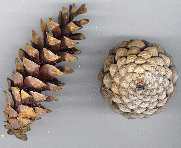
The most irrational number
There are many web resources on the golden mean and Fibonacci
numbers. See in particular Ron Knott's Fibonacci Numbers and the Golden Section
and Steven Finch's MathSoft page The Golden Mean which has many useful links. There is
not much information on the Web about continued fractions. The theorems
I have quoted in typed format appear in C. D. Olds,
Continued Fractions (Random House New Mathematical Library, New York,
1963) or in A. Rockett and P. Szüsz Continued Fractions
(World Scientific, Singapore, 1992). There is a very nice page on
Symmetry in Plants: Phyllotaxis at Smith College, with illustrative applets.
An irrational number by definition is one
which cannot be written as the ratio of whole numbers. So
it would seem that all irrational numbers are equally irrational.
All pigs are equal, Orwell said, but some are more equal
than others. And in fact there is a precise sense in which
some irrational numbers are more irrational than others. This
phenomenon has had important consequences in the organization of
the natural world. In packing seeds around a core, many plants choose
the strategy of placing each one at the most irrational angle
possible to the one directly below it.

Rotation through the most irrational angle leads
to seed packing patterns
with numbers of left- and right-diagonal
rows given by consectutive Fibonacci numbers:
(3,5) and (5,8) for
the two pine cones shown here. Larger image.
This column will present the ideas of rational approximation and the
concept of some numbers being better approximated by rationals than
others. We will look at the most irrational number and at how its
use in plant growth leads to the occurrence of Fibonacci numbers in
seed-packing patterns.
--Tony Phillips
© copyright 1999, American Mathematical Society.


